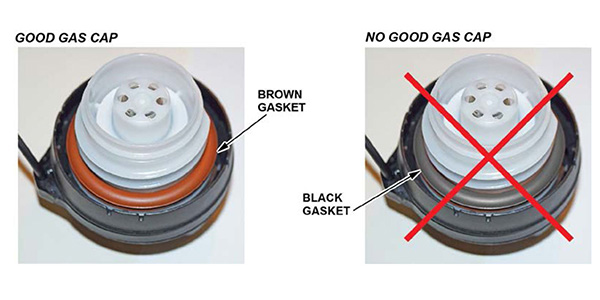If you’re concerned that your gas cap may be leaking, there is a simple way to test it. First, make sure the cap is screwed on tightly. Next, put a piece of paper or a napkin over the top of the gas cap and try to unscrew it.
If the paper sticks to the cap, it’s likely that there are no leaks. However, if the paper comes off easily or if there is any resistance when trying to unscrew the cap, this could indicate a leak.
- Check the gas cap for cracks or damage
- If the gas cap is damaged, it will need to be replaced
- Clean the area around the gas cap
- This will help ensure that any leak is coming from the gas cap and not another area of the car
- Place a piece of paper or cardboard under the gas cap
- Tighten the gas cap until it clicks
- Then wait a few minutes to see if any gasoline leaks onto the paper or cardboard
- If there is no gasoline on the paper or cardboard, then the gas cap does not appear to be leaking
Test Gas Cap Autozone
If you’re looking to test your gas cap, Autozone has the perfect tool for the job. The EVAP system tester is quick and easy to use, and will give you an accurate reading of whether or not your gas cap is working properly. Here’s a step-by-step guide on how to use it:
1. Start by making sure your gas tank is at least half full. This will ensure that there’s enough pressure in the system for the tester to work properly.
2. Next, locate the EVAP system tester at your local Autozone store.
It should be located near the other diagnostic tools.
3. Once you have the tester, connect it to the gas cap on your car. Make sure that the connection is snug and secure.
4. Now, turn on the tester and wait for the results. If the light on the tester turns green, then your gas cap is working properly.
Vaseline on Gas Cap
If you’ve ever been driving down the highway and noticed a car with a glistening, gooey substance on the gas cap, chances are that it’s Vaseline. But why would someone put Vaseline on their gas cap?
As it turns out, there are a few reasons.
The first is that it can help to seal the gas cap and prevent any vapors from escaping. This can be especially helpful in cold weather when those vapors can freeze and cause the gas cap to become stuck.
Another reason is that Vaseline can act as a lubricant, making it easier to remove the gas cap when you need to fill up your tank.
No one likes struggling with a stubborn gas cap!
So if you see a car with Vaseline on the gas cap, now you know why. It’s not just some strange quirk – there’s actually a method to the madness.
How to Test Gas Cap Pressure
If you have a gas cap pressure test kit, follow these steps:
1. Connect the pressure gauge to the test port on the gas cap.
2. Pressurize the gauge to the specified pressure.
For most kits, this is 15 psi.
3. Slowly release the pressure from the gauge while observing the needle on the dial.
4. If the needle falls below zero, there is a leak in the gas cap and it needs to be replaced.
What Does a Bad Gas Cap Look Like
If your car’s gas cap is damaged or missing, it can cause all sorts of problems. A damaged gas cap can cause your car to leak fuel, which is not only a fire hazard but also a waste of money. A missing gas cap can also trigger the “check engine” light on your dashboard, as well as reduce your car’s fuel efficiency.
So, what does a bad gas cap look like? Well, it depends on the type of damage. If the gas cap is simply loose, you may not notice anything out of the ordinary.
However, if the seal is broken or there is a hole in the gas cap, you will likely see signs of fuel leakage. This could be anything from a puddle of gasoline under your car to a strong smell of gasoline inside the cabin.
If you suspect that your gas cap is damaged or missing, don’t hesitate to take it to a mechanic for inspection.
They will be able to tell you for sure and advise you on the best course of action. In most cases, replacing the gas cap is all that’s needed to fix the problem.
Gas Cap Leak Fix
If you’re like most people, you’ve probably had a gas cap leak at some point. Maybe it’s happened when you’ve filled up your tank and then driven for a while, only to come back and find gasoline dripping from beneath your car. Or maybe you smell gasoline fumes but can’t seem to find the source.
Either way, a gas cap leak is no fun. Not only is it annoying, but it can also be dangerous if the fumes ignite. So what causes these leaks, and how can you fix them?
There are two main reasons why gas caps leak: either the O-ring seal is damaged or the cap itself is loose. The O-ring seal is a small rubber ring that sits between the cap and the neck of the gas tank. Over time, this seal can become cracked or brittle, which allows gasoline to seep out.
The other reason for leaks is a loose fit between the cap and the neck of the tank. This can happen if the threads on either piece are worn down or damaged. It can also occur if you don’t screw the cap on tightly enough.
Either way, this problem is easily fixed by simply screwing on the cap more tightly until it’s snug against the neck of the tank.
If your gas cap leaks due to a damaged O-ring seal, then you’ll need to replace that seal before using your car again. You can do this yourself with a new O-ring (available at any auto parts store) and some lubricant such as WD-40 or silicone spray lubricant.
First, remove any dirt or debris from around the edge of the gas cap with a rag so that the new O-ring will seat properly against both surfaces. Then coat both sides ofthe new O-ring with lubricant and carefully place it overthe opening inthegas caplid wherethe old one came outof . Finally , screwonthecapand testforleaksby fillingupthetankanddrivingaroundfor awhile .
If thereareno moreleaks , thenyou’re allset ! However ,ifyou stillhavea leakingproblem ,thenyoumayneedto takeyourcarto agarageor dealerfor furtherdiagnosisandrepair .

Credit: www.tomorrowstechnician.com
How Do You Know If Your Gas Cap is Leaking?
If you notice that your car is taking longer to fill up with gas or that the needle on your gas gauge is dropping faster than usual, it could be a sign that your gas cap is leaking. Other symptoms of a leaking gas cap include a hissing sound when the car is running and a strong gasoline smell inside the car. If you suspect your gas cap is leaking, take it to a mechanic to have it checked out.
Can a Gas Cap Be Tested?
Yes, a gas cap can be tested. There are a few ways to do this, but the most common is to use a pressure tester. This device attaches to the gas cap and measures the amount of pressure that is being released.
If the gas cap is not working properly, it will not release the correct amount of pressure and will need to be replaced.
How Do I Know If My Gas Cap Needs Replacing?
If your gas cap is not sealing properly, it can cause your “check engine” light to come on. A hissing noise when you remove the gas cap may also be an indication that it needs to be replaced. If you have a loose or damaged gas cap, it is important to replace it as soon as possible.
How Do You Test a Gas Cap Vent?
If you have a gas cap vent, you will need to test it to see if it is working properly. There are a few ways that you can do this, but the most common way is to use a pressure tester. You will attach the pressure tester to the gas cap vent and then turn on the engine.
If the pressure tester does not show any movement, then the gas cap vent is not working properly.
How to find an EVAP leak. Bad gas cap ??
Conclusion
If you suspect your gas cap is leaking, there’s a simple way to test it. First, clean the area around the cap with a rag. Then, put a piece of paper or cardboard under the cap and tighten it until you can’t anymore.
Next, remove the cap and check the paper or cardboard for any gasoline stains. If there are any, that means your gas cap is leaking and needs to be replaced.
